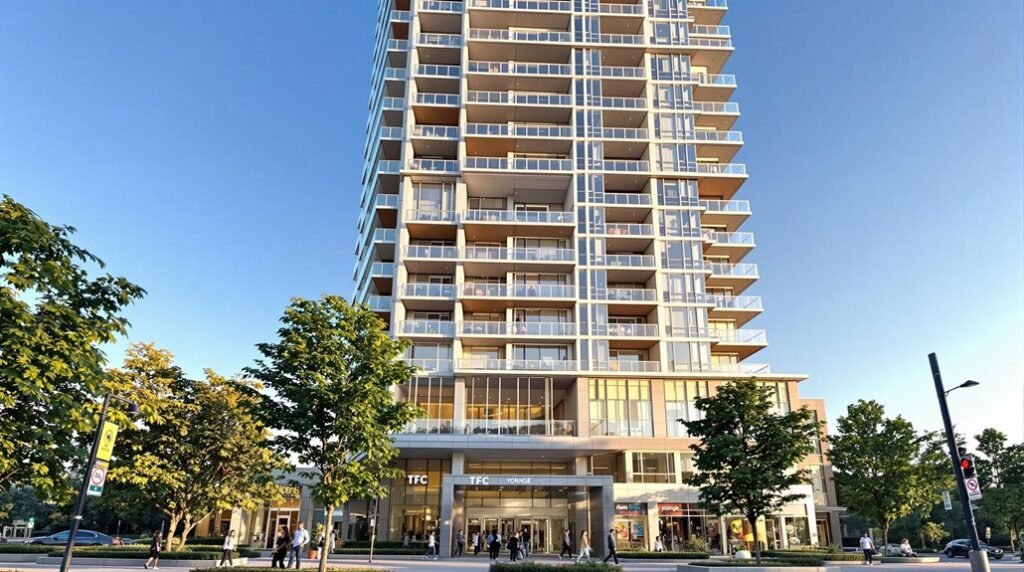As you look into the Toronto real estate market for July 2024, you’ll notice an intriguing mix of growth and challenges. Neighborhoods like Yorkville and Leslieville have seen significant price hikes, reflecting a broader trend across the city. Yet, limited property supply and high demand are pushing affordability to the forefront of conversation. Despite this, declining mortgage rates are offering some relief. The influence of government policies and economic indicators can’t be ignored either. Curious about which areas are now more accessible for first-time buyers or how remote work is shifting preferences? Let’s dive deeper into these dynamics.
Key Takeaways
- Downtown Core condos increased by 40-50% over 5-7 years, now priced between $800,000 and $1.2 million.
- Mortgage rates are declining, currently at around 5.23%, improving affordability and market activity.
- High demand and limited supply in the rental market contribute to competitive bidding wars for condos.
- Government interventions aim to boost housing supply, with a focus on property intensification and transit-oriented development.
- TRESA enhances transparency in the real estate market, ensuring a fairer offer process and improved client representation.
Toronto Neighborhood Home Prices: Current Trends vs Past

Take a look at how home prices in Toronto neighborhoods like Downtown Core, Yorkville, and Leslieville have surged dramatically over the past decade. Comparing different neighborhoods, you’ll notice substantial price fluctuations and varying degrees of investment potential. For instance, Downtown Core condos, currently averaging between $800,000 and $1.2 million, have experienced a 40-50% price increase over the last 5-7 years. In Yorkville, where condos and townhouses range from $1.5 to $3 million, prices have risen by 30-40% in just five years.
Analyzing historical data reveals that Leslieville has seen some of the most significant price hikes, with house prices soaring by 50-60% in the past 5-7 years, now averaging $1 to $1.5 million. Similarly, Riverdale and Roncesvalles have both experienced 40-55% increases, underscoring their strong investment potential.
A detailed market analysis shows other neighborhoods like The Annex, High Park, and the Beaches also reflecting notable growth. The Annex, with house prices between $1.5 and $2.5 million, has seen a 35-45% rise, while High Park and the Beaches, both averaging $1.3 to $2 million, have experienced 30-45% increases.
Scarborough and North York, traditionally more affordable areas, have not been immune to these trends. Scarborough houses, now ranging from $750,000 to $1.2 million, have surged by 50-60%, while North York homes, averaging $1 to $1.5 million, have risen by 40-50%.
These neighborhood comparisons highlight the dynamic nature of Toronto’s real estate market, presenting varied opportunities for investment based on historical data and current market analysis.
Toronto Property Supply and Demand Balance
Toronto’s real estate market has been marked by a chronic imbalance between the limited supply of housing and the high demand from both domestic and international buyers. This ongoing mismatch is evident across various market segments, including the rental market, luxury properties, and condos.
The rental market in Toronto remains tight due to the insufficient availability of rental units, exacerbated by a growing population. High condo demand is another significant factor, as new constructions struggle to keep up with the influx of people looking for urban living spaces. This high demand often leads to bidding wars and rapid property sales, increasing the competitiveness of the market.
Luxury properties are not immune to this imbalance. While there are more high-end homes available compared to other segments, the demand from affluent buyers and investors keeps this market segment highly competitive. These properties are seen as prime investment opportunities, attracting both local and international interest.
Urban sprawl has also played a role in the supply-demand dynamic. As the city expands outward, the development of new housing in suburban areas has not been sufficient to meet the growing demand. Zoning restrictions and lengthy approval processes further limit the ability to increase housing supply quickly.
Despite various government interventions aimed at alleviating the supply shortage, such as incentivizing new construction and speeding up approval processes, the challenge persists. Projections indicate that population growth will continue to pressure housing demand, making it unlikely that the supply-demand balance will be achieved in the near future. This persistent imbalance remains a critical factor shaping Toronto’s real estate market, driving up property prices and maintaining a competitive buying environment.
Mortgage Rates Impact on Toronto Real Estate
 real estate trends” width=”1006″ height=”575″ />
real estate trends” width=”1006″ height=”575″ />You’ve likely noticed that Toronto’s mortgage rates, while still high, are on a downward trend, which is starting to improve affordability for buyers. This shift allows homebuyers to stretch their budgets further, potentially increasing their purchasing power in the city’s competitive market. Consequently, this change is expected to rejuvenate market activity, leading to higher sales volumes and a more balanced market dynamic.
Current Mortgage Rates: “Toronto Mortgage Rates: High But Declining”
Despite remaining relatively high, mortgage rates in Toronto have started to show a gradual decline, offering potential relief to homebuyers. Interest rate fluctuations have a direct impact on affordability, a critical factor in the housing market. Lower rates can ease financial strain, making homes more accessible to a broader range of buyers.
Toronto’s market dynamics are influenced by these rates, affecting home prices and overall demand. When mortgage rates decrease, buyer sentiment tends to improve, leading to increased activity and competition in the market. Conversely, higher rates can dampen enthusiasm, slowing down sales and potentially stabilizing or even reducing home prices.
The current mortgage rate environment also plays a significant role in real estate trends and investment opportunities. With the 5-year fixed rate now around 5.23%, compared to the previous months, there’s a noticeable shift in the housing market. Economic indicators such as employment rates and consumer confidence further influence these trends, shaping the broader landscape.
You’ll notice that as rates decline, the potential for more favorable investment opportunities increases. Keeping an eye on these economic indicators will help you understand the housing market’s direction and make more informed real estate decisions.
Impact on Buyer Affordability: “Higher Rates Squeeze Toronto Homebuyer Affordability”
Higher mortgage rates are squeezing the affordability of homes for buyers in Toronto to a large extent. As rates surge, the affordability challenges become more pronounced, with notable impacts on buyers’ financial situations. Higher rates directly affect monthly mortgage payments, making homeownership more expensive.
- Affordability challenges: For an average home priced at $1,165,691 and a 20% down payment, monthly mortgage payments are around $2,900, with $2,100 going towards interest costs. This consumes a large portion of the median after-tax family income of $5,700.
- Reduced purchasing power: Rising rates mean buyers can afford less expensive properties for the same monthly payment, significantly impacting their purchasing power.
- Increased down payment requirements: To offset higher monthly payments, some buyers are opting for larger down payments, a challenging feat in Toronto’s costly market.
- Interest impact and rate effect: Higher rates lead to a substantial affordability struggle, directly squeezing Toronto homebuyers’ finances.
The rate effect on buyers is profound; as interest rates rise, the purchasing power of potential homeowners diminishes, making it increasingly challenging to enter the market. This Toronto homebuyer squeeze highlights the remarkable impact of rising rates on overall affordability.
Effects on Market Activity: “Toronto Housing: Slower Sales, Rising Inventory”
As rising mortgage rates squeeze affordability for Toronto homebuyers, the housing market is experiencing slower sales and a surge in inventory. In May 2024, total home sales in the Greater Toronto Area (GTA) dropped by 21.7% year-over-year, with 7,013 sales compared to 8,960 in May 2023. This decline in sales volume reflects significant market challenges and buyer hesitancy, as many potential buyers are waiting for mortgage rates to decrease before making a purchase.
The number of active listings has also climbed to a decade high, reaching 21,760 at the end of May 2024. This rising inventory, coupled with slower sales, suggests a shift in market dynamics. Homes are taking longer to sell, with the average days on market increasing from 20 days in May 2023 to 28 days in May 2024. Despite these trends, home prices have shown resilience, with a modest 2.5% year-over-year decrease to $1,165,691 in May 2024.
As affordability continues to be a concern, rental market pressures are growing. With homeownership becoming less attainable, rental demand is surging, leading to low vacancy rates and rising rents. While future interest rate decreases may offer some relief, affordability challenges are expected to persist.
2024 Policies Affecting Toronto Housing Market
In examining the Toronto housing market, you should consider four key policies that notably impact it. These include TRESA, which aims to boost transparency and professionalism in real estate transactions, and PPS 2024, designed to increase housing supply and urban intensification. Additionally, new income-based definitions for affordable housing and CREA’s rules on exclusive listings transparency are pivotal in shaping the market’s future dynamics.
TRESA: Transparency and Professionalism in Realty
TRESA’s introduction in December 2023 has revolutionized the Toronto real estate market by enhancing transparency and professionalism through four key policies. These policies aim to elevate industry standards, guarantee consumer protection, and promote professional conduct among real estate agents, ultimately leading to greater market transparency and agent accountability.
Here are the four key policies introduced by TRESA:
- Transparent offer process: Sellers can now disclose the details of competing offers to buyers, which reduces the opacity of bidding wars and enhances fairness.
- Shift in client representation: The terms ‘client’ and ‘self-represented party’ (SRP) have replaced ‘customer,’ providing clearer definitions of service levels and representation, thereby improving consumer protection.
- Enhanced disciplinary process: The Real Estate Council of Ontario (RECO) has been granted broader powers to discipline real estate professionals for non-compliance, ensuring higher professional conduct and accountability.
- Designated representation agreements: Agents from the same brokerage can represent both the buyer and seller in a transaction, potentially increasing flexibility and efficiency in deal-making while maintaining ethical standards.
These changes are designed to foster a more transparent, professional, and accountable real estate environment in Toronto. By setting higher industry standards and guaranteeing rigorous consumer protection measures, TRESA is making a significant impact on how real estate transactions are conducted.
PPS 2024: Housing Supply and Intensification
The proposed updates to the Provincial Policy Statement (PPS) 2024 could reshape Toronto’s housing market by promoting increased supply and higher-density developments. These changes aim to address housing affordability and encourage urban development by focusing on property intensification. Specifically, the PPS 2024 encourages the redevelopment of low-density areas, such as plazas and shopping malls, into mixed-use residential developments. This approach aims to create a more efficient use of land and increase housing diversity, offering a range of housing options, including multi-unit types and affordable housing.
Moreover, the PPS 2024 promotes transit-oriented development, encouraging higher density construction near major transit stations and frequent transit corridors. This policy aims to enhance transit accessibility, making it easier for residents to commute and reducing reliance on personal vehicles. By setting local targets for affordable housing, municipalities will be required to ensure a portion of new developments meet affordability criteria, further contributing to housing affordability.
Additionally, the collaboration between municipalities and post-secondary institutions on student housing strategies highlights the government’s commitment to addressing the diverse housing needs of Toronto’s residents. These proposed updates to the PPS 2024 could greatly impact Toronto’s real estate landscape by fostering a more inclusive and accessible urban environment.
Affordable Housing: New Income-Based Definitions
While Toronto’s real estate market continues to evolve, new income-based definitions for affordable housing are reshaping the landscape. The adoption of Official Plan Amendment 558 in late 2021 marked a significant shift from previous market rent-based definitions to more inclusive, income-based criteria. This change has had a profound community impact, improving housing equity and fostering income diversity.
By introducing ‘mid-range rents’ categories, Toronto aims to address a broader spectrum of affordability challenges. These new definitions affect how affordable housing is implemented in new developments, potentially altering the mix of housing types available.
Here are the key aspects of this policy shift:
- Community Impact: Enhanced focus on creating mixed-income neighborhoods.
- Income Diversity: Encourages a wider range of income levels within communities.
- Housing Equity: More equitable access to housing for lower and middle-income families.
- Affordability Challenges: Aims to mitigate the rising cost of living and housing in Toronto.
These income-based definitions promote social inclusion by ensuring that affordable housing is accessible to a diverse population. As a result, Toronto’s approach to affordable housing is more responsive to the needs of its residents, creating a more balanced and inclusive real estate market.
CREA: Exclusive Listings Transparency Rules
Building on the theme of fostering transparency and equity in Toronto’s real estate market, the Canadian Real Estate Association (CREA) implemented new rules in January 2024 targeting ‘exclusive’ or ‘pocket’ listings. These CREA regulations mandate that exclusive listings be added to the Multiple Listing Service (MLS) within three days. This change aims to enhance real estate transparency by ensuring broader access to property information, thereby leveling the playing field for all buyers and sellers in the Toronto market.
In conjunction with this, CREA has also imposed restrictions on ‘Coming Soon’ marketing practices. These practices previously allowed sellers to advertise properties before officially listing them on the MLS, often creating an air of exclusivity and potentially limiting access. By curbing these practices, CREA intends to make the market more equitable and transparent.
The exclusive listings impact is particularly notable in the high-end market segment, including the marketing of celebrity properties. These changes could alter how such properties are marketed, pushing for greater inclusivity and reducing off-market transactions. Overall, these CREA regulations represent significant Toronto market changes, promoting a more transparent and fair real estate environment.
Economic Influences on Toronto Real Estate

Economic factors frequently play a pivotal role in shaping Toronto’s real estate market, dictating trends in housing demand, supply, and pricing. Various economic indicators, like employment rates, inflation, and population growth, interact to influence market dynamics significantly.
Toronto’s strong job market has a notable employment impact on housing demand. High employment rates enhance consumer confidence, enabling more people to afford homes. This leads to increased demand and higher housing prices. Conversely, job losses can reduce demand and potentially lower prices.
Population growth is another vital factor. Toronto has seen substantial growth due to both natural increase and immigration. This surge in population has heightened demand across all housing segments, often outstripping supply. Consequently, the city faces upward pressure on housing prices, exacerbating housing affordability challenges, especially for first-time buyers.
Inflation also affects Toronto’s real estate market. Rising inflation can increase construction costs, slowing new developments. Higher mortgage interest rates, spurred by inflation, make home buying less affordable. However, real estate often acts as a hedge against inflation, boosting investor sentiment and demand.
The interplay of these factors creates a complex environment for Toronto’s housing market. Here are some key points to bear in mind:
- Supply and Demand Imbalance: High demand often surpasses supply, pushing prices up.
- Affordability Challenges: Rising costs make it tough for many, particularly first-time buyers.
- Investment Attraction: Toronto’s market draws both domestic and foreign investors.
- Development Pressures: Population growth drives the need for new housing solutions.
Understanding these economic influences helps you navigate Toronto’s ever-evolving real estate landscape effectively.
New Developments Impacting Toronto Property Values
New developments are greatly influencing property values across Toronto. You’ll notice that efforts to revitalize downtown and waterfront areas, along with transit-oriented projects, are boosting prices. Additionally, suburban growth in the 905 region and high inventory levels creating a buyer’s market are shaping neighborhood-specific price trends.
Downtown and Waterfront Revitalization Efforts
Toronto’s downtown and waterfront revitalization efforts are transforming these areas with new housing options like condominiums, townhomes, and mixed-use developments. These initiatives are designed to enhance urban living, attract more residents, and boost local businesses. By focusing on waterfront development and urban renewal, Toronto aims to make these neighborhoods more vibrant and desirable.
Urban renewal projects focus on modernizing infrastructure and improving public spaces, making downtown revitalization a priority. This focus on city center redevelopment has led to the construction of new mixed-use developments that combine residential, commercial, and recreational spaces. As a result, waterfront property values are expected to rise, owing to their improved amenities and accessibility.
Here are some key highlights of the revitalization efforts:
- Waterfront Development: New parks, pedestrian pathways, and green spaces are being added along the waterfront, enhancing its appeal.
- Urban Renewal: Older buildings are being renovated to blend historic charm with modern conveniences, attracting a diverse population.
- Downtown Revitalization: Increased investment in public transportation and infrastructure improves connectivity and livability.
- City Center Redevelopment: Mixed-use developments create a seamless integration of living, working, and leisure spaces, boosting property values.
These efforts are setting the stage for a more dynamic and prosperous Toronto.
Neighborhood-Specific Price Trends
Rising property values in Toronto’s diverse neighborhoods highlight the significant impact of new developments on the real estate market. For instance, luxury neighborhoods like Rosedale and Moore Park have seen home prices soar to an average of $2.8 million in April 2024, reflecting a 34.9% month-over-month increase. This substantial rise points to burgeoning investment opportunities arising from recent and upcoming developments in these areas.
Another remarkable area is The Annex and Yonge-St. Clair, where home prices averaged $1.9 million. Detached house prices here surged by 26.9% month-over-month and a striking 61.2% year-over-year. This dramatic increase underscores the effect of strategic real estate investments and upcoming developments, making these neighborhoods prime candidates for potential buyers seeking robust investment opportunities.
Transit-Oriented Development Boosts Property Values
As transit-oriented development gains momentum, property values near Toronto’s major transit stations and corridors are experiencing a significant boost. This trend underscores the growing importance of living close to public transit, offering both convenience and various long-term advantages.
Transit proximity is a key factor driving property appreciation. Homes and condos near transit hubs are in high demand, often commanding higher prices. This is because easy access to transit reduces commuting time, making these properties more appealing to buyers and renters alike.
For investors, the investment potential is substantial. Properties in these areas not only appreciate faster but also generate higher rental incomes. The consistent demand guarantees a stable return on investment, making it a savvy choice for both seasoned and new investors.
Urban growth is another significant aspect. Transit-oriented developments promote higher-density housing, leading to more dynamic and sustainable communities. These developments support local businesses and contribute to a vibrant urban environment.
Lastly, the community benefits from these projects are vast. Reduced reliance on private vehicles results in lower traffic congestion and pollution, enhancing the overall quality of life.
Suburban Growth in 905 Region
While transit-oriented developments are boosting property values in the city, suburban growth in the 905 region is also greatly impacting Toronto’s real estate market. This growth is largely driven by significant infrastructure improvements, which enhance connectivity and accessibility to suburban neighborhoods. With the 905 region offering a variety of community amenities, such as parks, schools, and shopping centers, the appeal of these areas is increasing for potential homeowners.
Suburban growth is further influenced by the urban feel that many suburban neighborhoods are adopting. These areas now feature mixed-use developments and vibrant town centers, providing a balance between urban convenience and suburban tranquility. For many buyers, the primary draw is housing affordability; suburban options in the 905 region are more cost-effective compared to Toronto’s high land costs.
Development projects contributing to suburban expansion include new residential complexes, commercial hubs, and public facilities. These initiatives not only provide more housing but also stimulate local economies and enhance the overall quality of life. As demand for properties in the 905 region continues to rise, it’s expected that property values in these suburban areas will see a positive trend, reflecting their growing desirability.
Buyer’s Market: High Inventory Levels
Toronto’s real estate market is currently experiencing a pivotal buyer’s market due to high inventory levels, giving you more negotiating power and potential price reductions. With the sales-to-new-listings ratio (SNLR) at 38% in May 2024, you’re seeing a clear shift in market conditions favoring buyers. This elevated supply creates opportunities to implement effective buyer strategies and leverage seller incentives.
Here’s how you can benefit from the current market conditions:
- Inventory fluctuations: High inventory levels mean more choices for you, potentially leading to better deals.
- Buyer strategies: Take advantage of the market by researching extensively and being prepared to negotiate hard.
- Seller incentives: Sellers might offer incentives like paying closing costs or including appliances to make their property more attractive.
- Price negotiations: Use the increased supply to negotiate lower prices or request additional concessions.
In this market, it’s pivotal to stay informed and proactive. The high inventory levels can drive down prices in the short term, but they may stabilize as demand catches up. By understanding the dynamics of inventory fluctuations and employing savvy buyer strategies, you can maximize your purchasing power and find the best deals.
Decreasing Mortgage Rates Stimulate Market
With high inventory levels favoring buyers, another key factor to take into account is the decreasing mortgage rates, which are expected to stimulate market activity and impact property values. Forecasts indicate that mortgage rates will gradually decline over 2024 and 2025. This rate decline is anticipated to provide considerable market stimulation as it lowers borrowing costs for potential homebuyers.
You’ll notice a significant mortgage impact as these lower rates make home purchases more affordable, encouraging more buyers to enter the market. This influx of buyers is likely to drive up demand, which in turn could lead to an increase in property values. For those who’ve been waiting for more favorable conditions, this rate decline offers substantial buyer relief, easing the financial burden associated with higher monthly payments.
The anticipated market stimulation due to decreasing mortgage rates isn’t just a short-term effect. Over the longer term, these conditions are expected to support property values, maintaining a healthier real estate market overall. As more people take advantage of these lower rates, the increased activity could lead to a more competitive environment, ensuring steady growth in property values across Toronto.
Toronto vs Other Canadian Cities’ Real Estate

Comparing Toronto’s real estate market to other Canadian cities reveals significant differences in price growth, affordability, and market activity. Toronto has historically experienced substantial price growth, often outpacing other cities. In recent years, Vancouver and Montreal have also seen significant increases, but Toronto remains a leader in price trends. Supply constraints due to geographical and regulatory factors further exacerbate this, making Toronto’s market more competitive and volatile.
Toronto’s market activity is among the highest in Canada, with frequent competitive bidding and low inventory levels. This intense activity is fueled partly by significant foreign investment, similar to Vancouver but more pronounced than in places like Calgary or Ottawa. These economic factors make Toronto’s real estate a bellwether for national trends, closely tied to the country’s overall economic performance.
Affordability remains a key issue. Toronto is considered one of the least affordable markets in Canada, alongside Vancouver. Other cities like Montreal, Ottawa, and Calgary offer more affordable alternatives, although they cannot match Toronto’s robust market activity and price growth.
To give you a clear picture:
- Price trends: Toronto leads in price growth, driven by high demand and supply constraints.
- Market comparisons: Toronto’s market is more active and competitive than most other Canadian cities.
- Foreign investment: Significant in Toronto, influencing market dynamics and contributing to higher prices.
- Economic factors: Toronto’s real estate market is a national economic indicator, reflecting broader economic trends.
These factors collectively shape Toronto’s unique real estate landscape, setting it apart from other Canadian cities. Understanding these differences can help you navigate the complexities of the market more effectively.
Remote Work’s Effect on Toronto Housing Preferences
As Toronto’s real estate market continues to outpace other Canadian cities, remote work is reshaping housing preferences and neighborhood dynamics in significant ways. Remote work’s impact on Toronto housing preferences is evident in the urban exodus, where many residents are moving away from the city’s core. With the flexibility to work from anywhere, people are opting for larger homes that can accommodate a dedicated home office, leading to a noticeable Toronto housing shift characterized by suburban sprawl.
This changing Toronto neighborhood dynamic is driven by remote migration, as individuals and families seek more spacious and affordable living conditions outside the urban center. Toronto real estate trends show a significant increase in home office demand, with buyers prioritizing properties that offer extra rooms or flexible spaces suitable for remote work. Additionally, the Toronto housing market is experiencing a rural relocation trend, where people are moving to quieter, more scenic areas with lower living costs, often referred to as ‘Zoom towns.’
The emphasis on home amenities has also shifted, with high-speed internet, reliable cell phone reception, and private outdoor spaces becoming vital selling points. This demand for better connectivity and outdoor areas reflects the lifestyle changes brought about by remote work. Moreover, local economies in these suburban and rural areas are adapting to the influx of new residents, resulting in increased demand for local services and amenities.
Foreign Investment in Toronto’s Real Estate Market

Foreign investors have played a significant role in shaping Toronto’s real estate market, despite recent policy changes aimed at curbing their influence. The foreign investor impact has fluctuated, but it remains a pivotal factor in market trends, particularly in housing affordability and rental market dynamics.
The introduction of the Non-Resident Speculation Tax (NRST) in 2017, which was increased to 20% in 2022, aimed to discourage foreign speculation and make housing more affordable for local buyers. Despite these measures, foreign investors continue to participate, particularly in luxury properties and pre-construction condominiums. This selectivity creates pronounced effects in specific market segments and continues to influence overall economic contributions.
Foreign investment has several implications:
- Competition: Foreign investors still drive competition, particularly for high-end homes and condominiums.
- Price Pressure: Their presence can exert upward pressure on home prices, especially in desirable neighborhoods.
- Rental Market Dynamics: Many foreign-owned properties are rented out, contributing to the rental supply but also potentially driving up rental prices in certain areas.
- Economic Contributions: Foreign investment fuels construction and related services, boosting job creation and economic growth.
Indirectly, the perception of strong foreign investment can influence local buyer behavior. This often results in increased urgency among local buyers to enter the market, fearing they might be priced out. However, accurate data on foreign investment can be challenging to obtain, as some investors use local proxies or corporations to purchase properties, potentially understating the true extent of foreign activity.
Toronto Real Estate Market: Short-Term Predictions
Toronto’s real estate market is expected to see moderate price growth and increased inventory over the next few years. Experts project annual price increases between 2-5%, signaling a slowdown from the rapid appreciation observed previously. This moderation is partly influenced by anticipated higher interest rates from the Bank of Canada, which could temper demand and apply downward pressure on prices.
With more inventory entering the market, housing affordability might see slight improvements, although challenges will persist. The rental market, driven by ongoing immigration impact, remains tight. Immigrants, students, and individuals priced out of homeownership will continue to sustain high demand for rentals. Consequently, rental prices are likely to remain elevated.
The trend of suburban migration, although slower than during the pandemic’s peak, will continue as people seek more space and affordability outside the city core. This movement could relieve some pressure on urban housing markets but might also increase suburban demand.
Government policies aimed at enhancing affordability and increasing housing supply will play a significant role. Zoning changes and developer incentives may help ease supply constraints, although their impact will be gradual.
Economic factors, such as employment rates and GDP growth, will also influence the market’s trajectory. A robust economy could bolster housing demand, while economic downturns might precipitate a market correction. Analysts caution that significant interest rate hikes or worsening economic conditions could trigger such corrections, underscoring the market’s volatility.
What Are the Key Trends and Insights in the Toronto Real Estate Market for July 2024?
Toronto real estate market insights for July 2024 reveal a complex landscape of growth and challenges. While neighborhoods like Yorkville and Leslieville have seen significant price increases, high demand and limited supply continue to push affordability issues to the forefront. However, declining mortgage rates are offering some relief, and government policies aimed at boosting housing supply and transparency are shaping the market’s future, with a focus on property intensification and transit-oriented development.
Popular Toronto Neighborhoods for First-Time Homebuyers

Many first-time homebuyers in Toronto gravitate towards neighborhoods that offer a blend of affordability, amenities, and growth potential. Finding the right area can make a significant difference in your overall living experience, and several neighborhoods stand out as excellent choices for those entering the housing market.
East York is one such neighborhood, known for its family-friendly atmosphere and relatively affordable housing options. This area provides a solid community atmosphere with plenty of neighborhood amenities, such as parks and schools, making it ideal for young families.
Another popular choice is Leslieville, a trendy neighborhood offering a mix of housing types and good public transit access. Leslieville’s growth potential is evident as it continues to attract new businesses and residents, enhancing its vibrant community atmosphere.
The Junction is an up-and-coming area that boasts a vibrant arts scene and diverse housing options. With its eclectic mix of shops, cafes, and galleries, it’s perfect for those who appreciate a creative community. The neighborhood also promises significant growth potential, making it a sound investment for first-time buyers.
Mimico, located in Etobicoke, is a waterfront community that offers more affordable condos and townhouses. This neighborhood provides excellent public transit access, making commuting to downtown Toronto convenient. Its scenic views and growing amenities contribute to its appeal for new homeowners.
When considering these neighborhoods, keep in mind the primary factors that attract first-time homebuyers:
- Neighborhood amenities
- Housing affordability
- Public transit access
- Community atmosphere
Choosing the right neighborhood involves balancing these factors to find a place that meets your needs and offers a promising future. Working with a local real estate agent can help you navigate the competitive Toronto market and secure the best possible home for your budget and lifestyle.
Conclusion
To sum up, Toronto’s real estate market remains strong despite its challenges. One interesting statistic is that home prices in key neighborhoods like North York have surged by over 40% in the past five years. This underscores the ongoing demand and limited supply issues. Decreasing mortgage rates are helping to offset some affordability concerns, yet policies and economic indicators will continue to shape future market dynamics. For first-time homebuyers, understanding these trends is essential for making informed decisions.
Looking to navigate the dynamic North York real estate market? Look no further than Realtor North York – The Fan Team. Our experts have the local knowledge and insight you need to make informed decisions, whether you’re buying your first home or expanding your investment portfolio. Contact us today to schedule a consultation and let us help you find your dream home in North York!

















